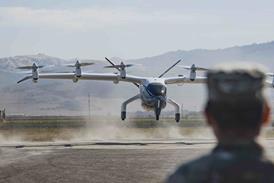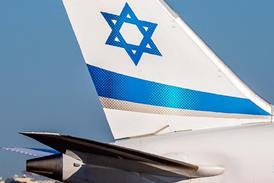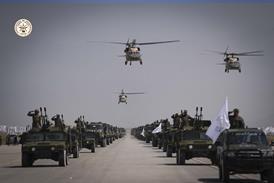Despite a troubled history, airship maker Zeppelin is making a comeback.
Andrzej Jeziorski/FRIEDRICHSHAFEN
IT SEEMS AS if, the golden age of rigid airships, is remembered by the general public, only in terms of romantic tragedy. The most enduring images are those of disasters such as the broken-backed R101 or the blazing Zeppelin LZ 129 Hindenburg.
The hydrogen filled Hindenburg in particular - filmed by news crews as it crashed down in flames on top of the crowds awaiting its arrival at Lakehurst, on 6 May 1937 - did much to label the airship as a suspect form of transport, while the subsequent destruction in Frankfurt of the giant LZ 127 Graf Zeppelin during the Second World War, was essentially the postscript to an era already ended. Since then, only small blimps have meandered the skies commercially, mostly carrying advertising, while ideas for new semi-rigid, or hybrid, airships have so far made little headway.
Now, however, the company, which was to rigid airships what Hoover is to vacuum cleaners, is returning to the products which made it famous. Zeppelin Luftschifftechnik (ZLT), based at Friedrichshafen on the German shore of Lake Constance, has begun assembly of a prototype New Technology (NT) airship for 12 passengers, which could be flying by early 1997.
BACK TO ITS ROOTS
Zeppelin envisages that the first prototype, called LZ N07, could develop into a whole family of NT airships, the biggest of which could carry 84 passengers. All this depends, naturally, on the accuracy of the market analyses, which spurred Zeppelin to return to its roots.
Luftschiffbau Zeppelin was founded by Count Ferdinand von Zeppelin in 1908, and still exists under the auspices of the Zeppelin foundation. The venerable former manufacturer of the early 20th century's airborne giants now owns 51% of ZLT, with the remaining 49% divided equally between engineering firm Zeppelin, gear specialist ZF Friedrichshafen and Lemforder Metallwaren.
ZLT itself, was founded in 1993 after studies begun in 1989, suggested that the airship may yet enjoy a revival.
Zeppelin's analysis confirmed that the days of rigid airships as long-range freight or passenger transports were long gone, simply because they could never match other forms of transport in terms of speed. Zeppelin did, however, suggest that a niche market exists between the fixed-wing aircraft and the helicopter, in roles which could take advantage of the airship's capabilities of vertical take-off and long, quiet and cheap loiter times.
Examination of the safety record of earlier airships showed that the most hazardous periods of operation were take-off and landing, with most accidents being caused by the airship's poor manoeuvrability. The ground crew was identified as both a safety problem and an economic one, accounting for a large chunk of operational costs.
It was also found that the traditional Zeppelin concept of a rigid frame inside the hull of the airship still offered advantages in safety - maintaining the shape of the envelope at higher speeds and in sharper manoeuvres - and performance, allowing more convenient location of propulsion units for speed and manoeuvrability.
NEW TECHNOLOGY
The NT generation of airships therefore has a lighter, simplified version of a rigid airship framework, inside a pressurised hull divided into discrete cells. The structure consists of three aluminum-alloy longerons running the length of the craft, while the cross section, is supported by triangular carbonfibre-composite frames.
This structure thus provides, fixing points for the propulsion units away from the passenger gondola, previously an impossibility for blimps. It also provides strong anchor points, simplifying ground handling and anchoring procedures.
According to Zeppelin, this primary structure accounts for only 12% of the total weight of the airship - less than half as much as on previous airship frames - and is much cheaper to produce. The carbonfibre-composite beams, which make up the frames, weigh just a little over 0.5kg a metre, but an 11m strut can take a 2t compression load.
Aluminum was selected for the longerons because it was easier to form the members to the required curvature of the airship's skin, and because the metal acts as a lightning conductor and has better deformation properties in the event of a crash.
The hull itself is made of a high-strength low-permeability laminate, with the outermost layer made of Kevlar, which Zeppelin claims is highly resistant to aging, allowing the airship to be permanently moored outside without the need to build large hangars. It is fastened to the primary structure along the longerons and inflated with helium at a low pressure of some 5bar (72lb/in2).
Mooring is carried out using either a fixed or mobile mast, with a semi-automatic mast-coupling procedure allowing the ground crew to be kept down to three people. This compares with a typical ground crew of 15 for a conventional blimp, (and indeed, about 100 people for a pre-Second World War Zeppelin) and represents a 30% cut in direct operating costs per flying hour, compared with competing airships, offsetting the higher cost of the rigid structure compared with a blimp, claims Zeppelin.
VECTORED THRUST
The propulsion units are three rotating vectored-thrust piston engines: one unit mounted on either side of the hull and one at the tail end, with an additional lateral-thrust fan mounted at the tail and driven by the rear engine. This arrangement allows for optimum manoeuvrability in pitch and yaw, and true vertical take-off and landing capabilities even when the craft is 10% heavier than air. The manufacturer has selected 150kW (200hp) Lycoming IO360 engines to power the LZ N07.
This airship's high manoeuvrability should allow it to operate in much higher winds than conventional blimps can. Zeppelin claims that its airship will be able to take off in 27kt (50km/h) winds, about twice the value for comparable blimps. The thrust-vectoring capability, along with fuel trim tanks, virtually eliminates the need for ballast management.
Three large fins with aerodynamic control surfaces are mounted at the tail of the craft. The control surfaces are controlled and coordinated with the thrust vectoring by a duplex digital fly-by-wire system, while the pilots steer the craft with side-sticks.
At low speeds, the rear propeller is vectored downwards, triggering a switch, which allows the pilot to control both propeller and lateral fan with the side-stick. This maintains pitch and yaw control at speeds too low for the aerodynamic control surfaces to function.
The pilots and passengers sit as usual in a carbonfibre-composite gondola slung under the hull, but, unlike in a blimp, they are comfortably removed from the noise of the engines. The LZ N07 gondola will be some 11m long. The attachments holding the gondola to the frame are crucial: as in former times, a hard landing could mean scrapping the whole airship. The unit is therefore attached to the frame by a combination of cables and struts, which are designed to deform elastically above a given limit load.
On the ground, the airship sits on tandem sets of landing gear - one leg supporting the gondola, one aft under the tail. The gear arrangement allows both vertical and short takeoffs and landings.
The technology incorporated into the new generation of Zeppelins makes an enormous difference in bulk compared with pre-war designs. The LZ N07 will be 68.4m long, with a volume of 7,200m3. The future LZ N30 concept, which could carry 84 passengers, is 110m long, with a 30,000m3 volume. By comparison, the ill-fated Hindenburg, which carried 90 `
The LZ N07 is predicted to have a maximum take-off weight of 6,950kg, with a payload of 1,850kg. It will cruise at 60kt and will be capable of a maximum 75kt, with a ceiling of 2,500m (8,200ft) and a maximum flight time of 18h at 38kt. By comparison, the Westinghouse Skyship 600, which has a similar capacity, cruises at 50kt and has a maximum speed of 60kt.
Zeppelin's prototype NT airship is due to be completed by July 1996, with its first flight scheduled for early 1997, and certification possibly coming the following year.
COMMERCIAL PRODUCTION
The company expects to begin commercial production in 1998, with an anticipated unit price of some DM10 million ($7 million). If successful, LZ N07 will be followed by the 46-seat LZ N17 - to be powered by three 300kW engines - and then eventually by the LZ N30.
The manufacturer predicts that its NT airships will be particularly suitable for applications such as maritime patrol, airborne remote sensing, environmental protection and tourism.
Zeppelin says that its airships could allow many tasks relating to control of territorial waters to be carried out by a single vehicle. The company claims that its craft will be able to stay on-station longer than any other airborne platform, and will be able to combine surveillance with on-the-spot interdiction.
The craft is also potentially a usefully stable, vibration-free, platform for airborne sensors and scientific research equipment, as well as being able to observe and collect data from the air on phenomena such as environmental problems. As far as tourism goes, the company is counting on its name to draw the crowds, as much as the airship's capability to allow passengers, to enjoy a leisurely birds eye view in comfort and silence.
Zeppelin thus sums up that its NT generation of rigid airships has "extremely promising market potential". The return of the company to airship manufacture has certainly stirred public interest, but interest in airships has been stirring for a long time without yet yielding a revival in substantial sales potential.
It therefore remains to be seen whether the manufacturer's fortunes will now rise like a Zeppelin of old, or drop like a leaky one.
Source: Flight International




















